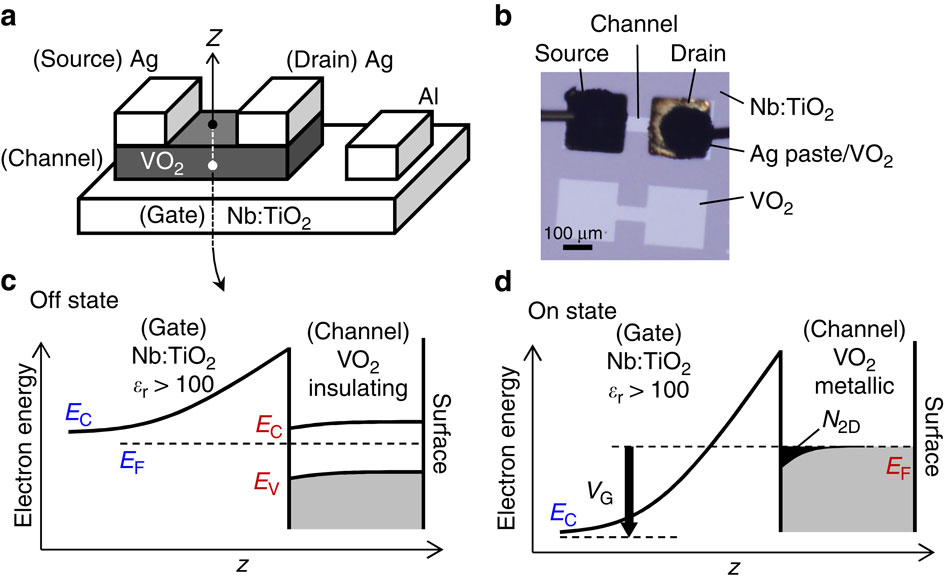Research Abstract
TiO2ゲート絶縁膜と極薄VO2チャネルを用いた金属絶縁体転移の正電圧ゲート変調
Positive-bias gate-controlled metal–insulator transition in ultrathin VO2 channels with TiO2 gate dielectrics
2015年12月14日 Nature Communications 6 : 10104 doi: 10.1038/ncomms10104

次世代のエレクトロニクスには、強誘電性や強磁性、金属絶縁体転移を示す材料など、さまざまな機能性材料が組み込まれる可能性が高い。金属絶縁体転移は、電子ドーピングによって制御できるので、そうした材料をトランジスターのチャネルに組み込めば、トランジスターの電流を大きく変化させることができるようになる。しかし、ゲート絶縁体によって蓄積される電子の数が限られているため、あるいはイオン性液体ゲートでは電気化学反応が起こる可能性があるため、こうした金属絶縁体転移のゲート制御は困難であった。今回我々は、転移温度付近で金属絶縁体転移の正電圧によるゲート制御を実現している。逆ショットキーゲート構造におけるサブナノメートルの等価酸化膜厚の高誘電率TiO2ゲート絶縁体によって、ゲート制御に充分な数の電子が蓄積された。VO2チャネルの急激な転移をさらに利用して、容量結合を超える大きな電流変化がもたらされる。この固体動作によって、静電的な機構だけでなくゲート制御金属絶縁体転移の集団的性質も検討できるようになり、機能的な電界効果トランジスターを開発する道が開かれる。
Takeaki Yajima, Tomonori Nishimura & Akira Toriumi
Corresponding Author
The next generation of electronics is likely to incorporate various functional materials, including those exhibiting ferroelectricity, ferromagnetism and metal–insulator transitions. Metal–insulator transitions can be controlled by electron doping, and so incorporating such a material in transistor channels will enable us to significantly modulate transistor current. However, such gate-controlled metal–insulator transitions have been challenging because of the limited number of electrons accumulated by gate dielectrics, or possible electrochemical reaction in ionic liquid gate. Here we achieve a positive-bias gate-controlled metal–insulator transition near the transition temperature. A significant number of electrons were accumulated via a high-permittivity TiO2 gate dielectric with subnanometre equivalent oxide thickness in the inverse-Schottky-gate geometry. An abrupt transition in the VO2 channel is further exploited, leading to a significant current modulation far beyond the capacitive coupling. This solid-state operation enables us to discuss the electrostatic mechanism as well as the collective nature of gate-controlled metal–insulator transitions, paving the pathway for developing functional field effect transistors.

